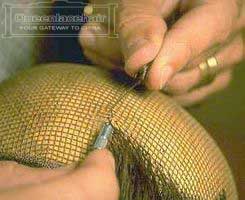


CopyFrom: Author:Alex DateTime:2014-10-09 Hits:0
Lace closures are made by hands and tend to look more natural than hair extensions. The material that is used in a lace closure was designed back in the 1970s. It does not have the capacity to stretch, which adds to the overall look of the closure. Ventilating is the method of tying hair strands to the lace base material. The process started during the reign of King Louis 16 of France,now this method is still used worldwide.
Things You'll Need:Head shaped wood block,lace base material.Ventilating needle.
Instructions:
1.Make sure the hairstyle you want to create, as this will determine the direction the hair strands need to go. With the base material on the head shaped wood block, use the ventilating needle to pull strands of hair through the holes in the base material. The ventilating needle resembles a fishing hook and can pick up a couple of strands of hair at a time. Start at the nape area. Use the ventilating needle to pull one to two strands of hair from the underneath side of the hole and through the hole. Fold the strand to make a loop, and put the curve of the hook into the loop. Pull it through the lace material base.
2.Hold the loose end of the strand of hair with one hand while using the ventilating needle. Keep the loop on the hook and swing the hook around to grab the two strands that were made when the single hair strand was folded. If you have used two strands of hair, you have created a total of four strands.
3.Bring those two strands (or four) up through the loop. This will form a knot around the lace material. Pull the knot tight and move to the next hole in the lace material base.
4.Use this knot tying process and work all the way up the back of the lace closure. As you work, try to mix subtle shades of the hair to create a more realistic lace closure.
5.Once the back is completed, move to the sides and the front. At this point, only pull one strand of hair at a time through the hole of lace. This creates very small knots that are tight and hard to detect.